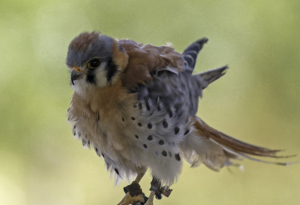American Kestrel – Irwin
Name: Iris – Male
Species: American Kestrel
Liberty Arrival: 2022 / Fledgling
Injury/Condition: Avian Trichomoniasis / Habituated
Irwin was found on the ground as a young fledgling with no apparent injury. He arrived extremely calm with stress fractures to his tail, which is indicative of a poor diet. He also had a minor case of avian trichomoniasis, which was quickly treated with medication. After being placed with other wild kestrels, it became clear he had no interest in hunting live prey. He was determined to be non-releasable due to his comfort with humans and was transferred to our education team.
American Kestrel Facts
Description: The American kestrel is one of the smallest falcons and they are one of the few raptors that the sex can be distinguished by the color of the feathers (this is known as sexual dimorphism). Males have blue-gray on their wings, a light chest and belly with dark polka-dots, and a barred tail. The female has rufous wings with black bars across them, a light chest and belly with darker streaks, and a striped pattern on the tail.
Habitat: American Kestrels are found in habitats ranging from deserts and grasslands to alpine meadows. You’re most likely to see them perching on telephone wires along roadsides, in open country with short vegetation and few trees.
Range: American Kestrels are found from central Alaska, through parts of Canada, throughout the United States, Mexico, Central America, and the Caribbean.
Life span: American kestrels live 2 – 10 years in the wild and 14 – 17 years in captivity.
Prey: Typical food prey includes large insects, small rodents, and small birds, reptiles, and amphibians.
Nests American kestrels are cavity nesters, nesting in holes or crevices in cacti, trees, buildings, or nest boxes. They do not make these nests but take over cavity nests left vacant by other species.
Babies: Kestrels lay 4 – 5 eggs in a clutch. The eggs hatch in about 28 days. Juveniles fledge (learn to fly) in about 25 days.
Cernícalo Americano – Irwin
Nombre: Irwin– Hembra
Especie: Cernícalo americano
Llegada a Liberty:
Herida/Condición:
Datos del cernícalo americano
Descripción: El cernícalo americano es uno de los halcones más pequeños y son entre una de las pocas aves de rapiña que se puede distinguir el sexo por el color de sus plumas. Los machos tienen plumas grises azuladas en sus alas, y su pecho y vientre son de color marrón claro con lunares oscuros y una cola rayada. Las hembras tienen plumas rufas con rayas negras sobre ellas. Su pecho y pansa son de marrón claro con rayitos oscuros, y sus alas, espalda y cola tienen las mismas rayas, pesan más y son más corpulentas que los machos.
Hábitat: Cernícalos americanos se encuentran en ámbitos desde los desiertos y praderas hasta los campos montañosos. Es más probable que puedas verlos poniéndose en los cables telefónicos de carretera, en campo abierto con vegetación corta y pocos arboles.
Ámbito de hogar: Cernícalo americanos se encuentran desde el área central de Alaska, hasta partes de Canadá, y por todas partes de los Estados Unidos, México, América Central, y el Caribe.
Duración de vida: Cernícalos americanos viven entre 2 -10 años en su hábitat natural, y entre los 14 – 17 años en cautiverio.
Presa: La presa típica que comen incluye insectos grandes, roedores pequeños, pájaros pequeños, reptiles, y anfibios.
Nidos: Cernícalos americanos se anidan en cavidades, como huecos o grietas en cacto, arboles, edificios, o pajareras. Ellos no construyen estos nidos, pero adquieran los nidos cavidades que fueron excavados por otras especies.
Crías: Las cernícalos hembras ponen 4 -5 huevos en una nidada. Los bebes salen del cascarón después de los 28 días. Los jóvenes echan las plumas (y aprenden como volar) a los 25 días.


